04-04-2024, 03:54 PM
![[Image: 7zscFjDl.jpeg]](https://i.imgur.com/7zscFjDl.jpeg)
My favorite movie of all time (other than The Great Escape) is a little-known gem called The Good Shepherd. It's a remarkable piece of cinema directed by Robert De Niro, delving into the clandestine world of the CIA from its inception as the OSS during WW2 to the tumultuous times around the Bay of Pigs invasion in 1961. Even Joe Pesci makes an appearance, portraying a fictionalized version of mobster Sam Giancana, engaging in a conversation with Matt Damon's character about what appears to be an attempted assassination of Castro.
While the film primarily revolves around the CIA's dealings, it offers a poignant commentary on the dynamics of the Cold War, particularly the perception of Russia as a formidable adversary. A defector from the Russian government, under LSD interrogation, describes Russia as nothing but "painted rust," suggesting that the U.S. sees Russia as a threat to justify its own system. This sentiment resonated strongly during the 1960s and most of the Cold War era, although its relevance has waned in recent times.
However, recent developments in Russian nuclear capabilities have reignited concerns about the nuclear rhetoric and modernization efforts. Among these is the Poseidon program, which particularly captures attention. Before delving into the specifics, it's worth noting the significant stockpiles and warhead yields between the U.S. and Russia.
In the U.S., the most powerful weapon in the arsenal is the B83 nuclear bomb, boasting a yield of 1.2 megatons of TNT. On the other hand, the Russian arsenal presents a murkier picture. While official records suggest their most potent weapons are no larger than ICBMs carrying up to 10 750-kiloton MIRVs, rumors swirl around the Poseidon program.
Poseidon is described as a nuclear-armed torpedo drone with a rumored yield of up to 100 megatons, nearly 8,000 times more powerful than the bomb dropped on Hiroshima. What makes Poseidon even more concerning is its association with the concept of a salted cobalt nuclear bomb. This type of weapon is designed to produce extensive radioactive fallout, rendering the target area uninhabitable for generations.
Adding to the tension, information about Poseidon was intentionally leaked on Russian TV, sparking fears of a potential arms race or a return to Cold War-era hostilities. These developments underscore the urgent need for international cooperation and arms control agreements to mitigate the risk of catastrophic consequences.
Furthermore, the Belgorod submarine, which houses the Poseidon system, adds another layer of complexity. This submarine, along with its stealthy nature, raises concerns about the difficulty in detecting and countering such a devastating weapon.
![[Image: RPvEpavl.jpeg]](https://i.imgur.com/RPvEpavl.jpeg)
One of the most terrifying aspects of Poseidon is its capability to create a radioactive tsunami. This would result in not only widespread destruction from the initial blast but also the contamination of coastal areas, causing long-term environmental and humanitarian disasters.
![[Image: lfIUx2Pl.jpeg]](https://i.imgur.com/lfIUx2Pl.jpeg)
In navigating this uncertain landscape, diplomacy and dialogue must take precedence to prevent the unimaginable from becoming a reality. As we confront the challenges of nuclear proliferation and technological advancements, the fate of humanity hangs in the balance.
![[Image: marx.png]](https://denyignorance.com/marx.png)









